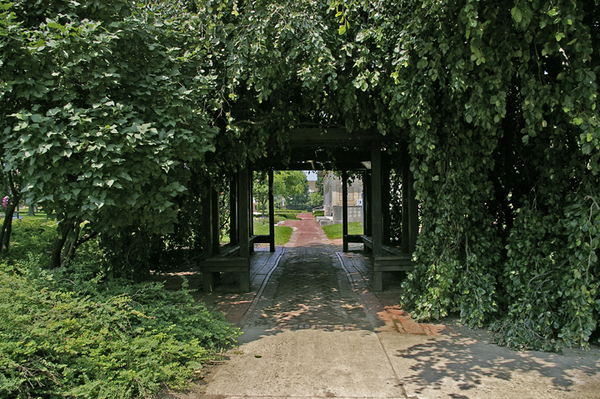Bacon Arbor
Date
Tree (planting date): 1954-present; arbor: 1984-presentLocation
Between Hall Auditorium and the Art Building's Venturi Addition near Main StreetArchitects/Collaborators
Oberlin CollegeHistory
The late Carl Bacon attended Oberlin in 1921-22, and lived at the Oberlin College Inn in the 1980s. He donated the funds for the entire landscape which surrounded Hall Auditorium and the Oberlin Inn (prior to the construction of the Lewis Gateway Center). He also contributed the funds for the construction of the Beech arbor, all in memory of his wife, Charlotte, who died in 1980. Carl Bacon died in 1988. The European Weeping Beech tree and the wooden structure underneath it, built in 1984, are called the Bacon Arbor in honor of the couple.A plaque installed in 1985 reads:
The Bacon Arbor
You are under the canopy of a European Weeping Beech, fagus sylvatica pendula. The Bacon Arbor, which protects the beech, is dedicated to Carl Bacon ‘28 and his wife, Charlotte Bacon who gave to Oberlin College the plantings surrounding Hall Auditorium.
Other types of beech trees flourish on the Oberlin College Campus. On the north side of Tappan Square near the center walk is a group of closely planted Native American Beech, fagus grandifolia; on the southeast side of Tappan Square along the College Street walk is a Cutleaf Beech, fagus sylvatica laciniata; on the south side of the King/Rice Building along West College Street is a Copper Beech, fagus sylvatica cuprea.
Oberlin College is duplicating, as far as possible, the natural requirement of the Weeping Beech. Annually the tree is mulched with hardwood bark, and its own leaves are allowed to accumulate. This care mimics the development of forest litter, providing the tree with cool, moist, and fertilized roots in summer and a thermal blanket in winter.
The forest environment protects beech trees from wind and storm damage. When used as an ornamental tree, the Weeping Beech must be encouraged to retain its natural shape and balance. Pruning on side would cause unequal distribution of its mass and pruning all sides would totally destroy its character.
The Bacon Arbor was designed to direct pedestrians along a straight course while maintaining the natural balance of the tree. Moreover, the Arbor protects the Beech’s roots by restricting access to the mulched area. The Weeping Beech’s roots must grow in oxygen--rich, loose forest litter and consequently are very close to the surface of the ground. Were the mulch and soil underneath this shallow-rooted tree to become compacted, the tree would suffocate.
Despite the Weeping Beech’s growth since its planting in 1954 it is still very young and will continue to grow for many decades. Its original cost was $650. Today a replacement would cost more than $20,000.
Because of the Bacon Arbor and the paved walk and benches, people and the Weeping Beech can live in harmony for years to come, with the tree growing larger, and the pleasure of seeing it becoming ever greater.
1985
Source
Oberlin College Archives, Carl Mitchell Bacon alumni record, Alumni and Development Records, RG 28.
Geolocation
Image Description
Color digital image by Serena Creary (OC 2017), 6 July 2015
(© Oberlin College Archives)

